#Roman town of Baiae
Explore tagged Tumblr posts
Text

Submerged Roman Villa Emerges in Lake Fusaro
The remains of a Roman village complex have started to emerge from the waters of Lake Fusaro due to a process of geological uplift known as bradysism.
Lake Fusaro is located in the comune of Bacoli in the Italian province of Naples. The lake and surrounding area are situated in the Phlegraean Fields, an active and volatile volcanic region of bradyseismic activity.
Bradyseism refers to the slow rise (positive bradyseism) or fall (negative bradyseism) of a section of the Earth’s surface, driven by the movement of magma or hydrothermal fluids beneath the ground.
The Phlegraean Fields sits within a collapsed caldera, namely a volcanic area formed by several volcanic edifices, which includes the Solfatara volcano, well known for its fumaroles (vents from which hot volcanic gases and vapours are emitted).
Adjacent to the lake are the partially submerged remains of the Roman town of Baiae, a popular resort in antiquity that gained a reputation for a “hedonistic lifestyle”. According to Sextus Propertius, a poet of the Augustan age during the 1st century BC, Baiae was a “vortex of luxury” and a “harbour of vice”.
On the opposite side of the Gulf of Naples are the remains of Roman Pompeii and Herculaneum, both major population centuries in antiquity that were buried under thick layers of ash and pumice during the AD 79 eruption of Mount Vesuvius.
According to a study by the National Institute of Geophysics and Volcanology, the area of Lake Fusaro has been rising since 2005, having rised in elevation by approximately 138 centimetres, 20 centimetres of which were recorded in 2024 alone.
This rapid acceleration has caused the seabed to rise and the shoreline to retreat, causing damage and difficult access to some ports and marinas along the coast.
An unexpected result of the bradyseismic activity is the emergence of a Roman villa visible in aerial photography. Josi Gerardo Della Ragione, the Mayor of Bacoli, explained that the villa likely had thermal baths, which will now be studied by the Superintendence of Archaeology, Fine Arts and Landscape of Naples.
#Submerged Roman Villa Emerges in Lake Fusaro#Roman town of Baiae#ancient artifacts#archeology#history#history news#ancient history#ancient culture#ancient civilizations#roman history#roman empire
91 notes
·
View notes
Text


Mosaic floor from a villa in Baiae, an ancient Roman luxury town which was submerged centuries ago due to volcanic activity in the area.
Photos: © Edoardo Ruspantini


The Campi Flegrei Archaeological Park. World Heritage Site
2K notes
·
View notes
Text
my day #myday. got to herculaneum as it opened and there was nobody else there and i got to wander round the empty town in a spectral manner. if i had a peristyle and frescoes. well let’s just say. haha. successfully bought lorde presale tickets sitting on the pavement in. herculaneum. ate a swagful calzone and experienced a small earthquake. marvelled at volcanic geology. got on a BOAT learned to snorkel and swam over baiae underwater archeological park genuinely one of the best things i’ve ever done in my LIFE despite my ailments (the nefarious underwater raynauds attack) shoutout to bradyseism. swimming over a perfect roman road is um. well. what the fuck
#<- when k started tagging this i was so excited about going to rome i forgot i was going to other places also#romeposting#things#beeps
81 notes
·
View notes
Text
Heritage News of the Week
Discoveries!
During a diving expedition in the Nile River, archaeologists in Egypt discovered rock carvings featuring depictions of several ancient Egyptian pharaohs, along with hieroglyphic inscriptions.
Bronze Age axe found off Norway’s east coast
The axe was discovered at a depth of 12 metres during a routine survey for the Norwegian Coastal Administration. It was found on the seabed in an accumulation of beach-rolled flint lumps and has been identified as a hollow axe made of Bronze from 1100 BC.
2,700-year-old military Roman port found in Parion, Türkiye
Underwater studies in Parion, a 2,700-year-old port city from the Roman Empire in Kemer village of Biga district of Çanakkale in northwestern Türkiye, revealed the second ancient port of the city.
Maya structures and pyramids discovered among Mexican tropical forests
Among Mexico’s dense tropical forests in central Campeche, archaeologists have identified pyramids and a ceremonial center, as well as a subterranean structure beneath a ball court constructed by the ancient Maya.
Earthquake at same time as eruption could have caused Pompeii deaths – study
Victims who perished in Pompeii after the devastating AD79 eruption of Mount Vesuvius may have been killed by a simultaneous earthquake, research has suggested.
Marvelous marble floor of sunken Roman villa restored in Bacoli
In Bacoli, Italy, an underwater restoration project has uncovered the marvelous marble floor of a submerged Roman villa. This remarkable find is part of an ongoing excavation by CSR Restauro Beni Culturali and Naumacos Underwater Archaeology and Technology at the Submerged Archaeological Park of Baiae, which aims to illuminate the most historically significant underwater region of the Roman Empire.
Viking arrowhead found frozen in ice
Archaeologists from the “Secrets of the Ice” project have discovered a Viking Era arrowhead during a survey of an ice site in the Jotunheimen Mountains.
Humans reached Argentina by 20,000 years ago — and they may have survived by eating giant armadillos, study suggests
The discovery of butchered bones belonging to a glyptodont, a giant relative of the armadillo, suggests that humans were living in Argentina 20,000 years ago.
Archaeologists discover traces of Roman circus at Iruña-Veleia
In a recent study using aerial photography and light detection and ranging (LiDAR), archaeologists have found a Roman circus and previously unknown urban areas of Iruña-Veleia.
An unexpected discovery in Pompeii: A Roman tomb reveals the existence of an unknown imperial position in Hispania
A surprising discovery in Pompeii gives us new information about the history of Spain between the 1st century B.C. and the 1st century A.D. The inscription on the tomb tells us of a brilliant military career followed by a quiet retirement in Pompeii, now a symbol of world archaeology, at the time a town in Campania renowned for the beauty of its landscape and views of the Gulf of Naples.
Archaeologists make new discoveries at Bodbury Ring hillfort
Archaeologists from Time Team and the Universities of Chester and York, recently conducted a study of Bodbury Ring using light detection and ranging (LiDAR). The study has revealed that Bodbury Ring is six times larger than previously thought and is part of a much larger hillfort which enclosed the entirety of the ridgetop on Bodbury Hill.
A 4000-year-old fabric found in a cave of skulls in the Judean Desert is the oldest dyed with insect dye
This textile, found in the Judean Desert and made of linen and wool dyed red, has been dated by direct radiocarbon to the Middle Bronze Age, specifically between 1954 and 1767 BC. What makes this find unique is the use of red dye derived from the insect Kermes vermilioa luxurious and rare source of color in ancient times.
Lost crusader altar discovered in holiest site of Christendom
Archaeologists from the Austrian Academy of Sciences (ÖAW), working in collaboration with the Israel Antiquities Authority (IAA), have discovered a lost crusader altar in the Church of the Holy Sepulchre.
The story of how they found this is hilarious. There was just a big stone slab leaning against the wall, covered in graffiti, and one day someone wondered what was on the other side.
Study reveals interior of Egyptian mummified crocodile
Scientists have used state of the art 3D imaging technology to piece together the life - and probable death - of a 2.2 metre-long crocodile mummified by the ancient Egyptians.

Medieval royal ring unearthed in Bulgaria
A ring has been found in a grave in a church at the site of Kokaliansku Urvich, a medieval fortress. The ring, found on the remains of the person’s hand, bears an image of an eagle, a medieval symbol of royal power, and is thought to link the wearer to the Bulgarian king Ivan Alexander. A rosette on the ring is thought to symbolize continuity and ancestral memory.
1,800-year-old ring depicting Roman goddess discovered by ancient quarry in Israel
A teenager hiking in northern Israel unexpectedly discovered an 1,800-year-old ring adorned with an engraving of a Roman goddess holding a sword and spear.
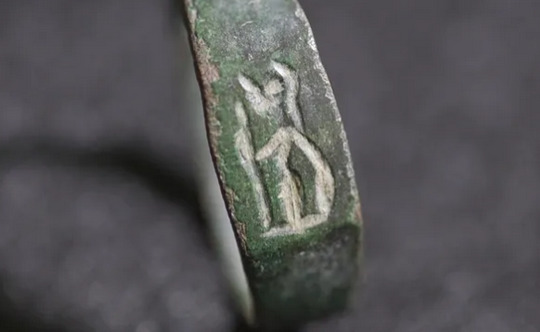
Underwater archaeologists find 112 glassware objects off Bulgaria’s coast
In the latest study, 112 whole and fragmented glass vessels were discovered, providing new insights into the trade and production in the Balkans during the Late Ottoman period.
Bones of fallen 19th-century Polish soldiers unearthed in Slovakia
The remains of six Polish soldiers killed in eastern Slovakia during the Battle of Budimír on December 11, 1848, have been unearthed by researchers from the East Slovak Museum,
Paper cuttings made by 17th-century schoolgirls discovered beneath floorboards
In the 17th century, girls attending a London boarding school learned to make decorative paper cuttings. Several of these creations—including a tiny fox, a star and a hen—survived for 350 years beneath the floorboards of Sutton House, a historic building that once functioned as a school for upper- and middle-class girls.
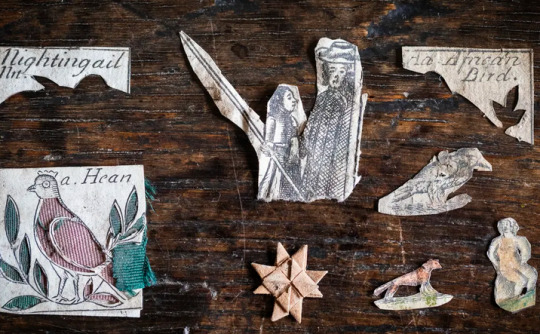
A mysterious human face carved on stone dated to Bronze Age discovered in Kazakhstan
A mysterious archaeological find has been uncovered in the Akmola Region of Kazakhstan. Employees of the Regional Emergency Situations Department came across a historical find in the form of a human face carved into stone and invited archaeologists to examine the artifact.
Museums
The public museum situated at the People’s Square announced last week that visitors will be allowed to bring their cats to a special series of events commemorating its forthcoming Egyptian antiquities exhibition, according to multiple reports from state-controlled news outlets.

This has nothing to do with the above story except that it involves cats. I just wanted an excuse to use it.
V&A beats out Met Museum to acquire $2.6m ivory sculpture of Christ
The Victoria & Albert Museum, also known as the V&A, recently raised the $2.6 million (£2 million) needed to acquire and save a 12th-century walrus ivory carving after a temporary export ban last November.
Colombian museum housing scientifically important fossils may close
For paleontologists studying the Miocene period in South America, which started about 23 million years ago and saw mammals diversifying in a warming world, a simple building in the town of La Victoria in the La Venta region of Colombia is a key destination. There, the Natural History Museum of La Tatacoa houses about 4000 well-preserved and often complete skeletons of animals, including Colombia’s biggest collection of ancient primates and specimens of rare ancient bats. But poor roads, which wash out when it rains, have reduced tourism and revenue and may force the museum to close.
London’s Science Museum ends contract with oil sponsor after protests
London’s Science Museum Group, a collective of five UK-run museums, has ended a sponsorship deal with the oil company Equinor after calls for its board to divest from the energy giant.
New funding brings Marines museum a step closer
A 19th century boathouse is a step closer to being transformed into a museum, following a multi-million pound cash infusion.
Brazilian artist steals historic coin from the British Museum as part of art project
Last month, the Brazilian artist Ilê Sartuzi stole a historic coin from its display case at the British Museum in London, and shortly after dropped the coin in the museum’s donation box, the Art Newspaper reported Monday.

Repatriation
The University of Iowa Stanley Museum of Art has become the first in the United States to restitue its holdings of Benin Bronzes, to the Oba of Benin, the former head of the royal family of Benin and steward of its legacy. Two objects, a brass plaque and wooden altarpiece, were formally returned in a ceremony held on July 15 at the Benin Palace in Nigeria.
New British Museum director says he has ‘hope’ for partnership with Greece on Parthenon Marbles
Nicholas Cullinan, the new director of London’s embattled British Museum, spoke this week of the possibility of an official agreement with Greece on the Parthenon Marbles, providing yet another sign that the institution is far more amenable than it used to be in resolving the longstanding dispute over these sculptures.
Chinese artefacts in repatriation row were ‘given willingly’ to British Museum
The British Museum boasts one of the biggest collections of Chinese antiquities in the west, but it has faced repeated calls to return them to China. Now historical documents reveal that many of the antiquities were acquired with the full cooperation of Chinese officials in the last century.
Germany Repatriates Taumualua Prow to Samoa
Germany repatriated the prow of a taumualua, or war canoe, to Samoa, in a ceremony held at the National University of Samoa (NUS), where it will be displayed.
Odds and ends
The African American Cultural Heritage Action Fund (AACHAF), a program of the National Trust for Historic Preservation, announced today that it is awarding $3 million in grant funding to protect and preserve 30 sites significant to Black history across the United States, with a focus on modern architecture, education, sports, and Black women’s achievement.
Lewd tourist antics on Florence statue lead to outrage
There has been outrage in Italy after a female tourist in Florence was pictured miming a lewd act on a statue of Bacchus, the Roman god of wine and excess.

Beloved statue of Hiroshima bombing victim stolen from Seattle park
The statue of Sadako Sasaki, who died of leukemia caused by exposure to radiation, was discovered on Friday severed from the ankles. The Seattle Police Department is investigating and said in a statement that local scrap collectors had been notified. City members, meanwhile, have theorized online that the bronze was taken by thieves who planned to sell the metal, suggesting that the robbers may not have had political motivations.

APPARENTLY THIS IS THE MOOD THIS WEEK
Colonial India through the eyes of foreign artists
A new exhibition in Delhi showcasing rare artworks by European artists gives insights into how the British ruled the country.
Nurse's lost journal reveals art therapy of WW1 survivors
A nurse's lost journal has revealed unseen sketches and writing from World War One, created by soldiers recoving at a Glasgow hospital. The book, dated 1917, gives an insight into how mentally-scarring conditions like shell shock were treated during the conflict.
Australia explorer laid to rest in village
A 19th century explorer credited with mapping and naming Australia has been laid to rest in the village of his birth.
Folklore student tracing the long, romantic journey of the sailor's valentine
When Meaghan Collins found a wooden box decorated with seashells among her grandmother's things as a chld, she was intrigued. Now the keepsake — known as a sailor's valentine — is the topic of the Memorial University folklore student's PhD dissertation, and she's hoping to discover more about their history.
Restoring destroyed historic landmark brings rural Alberta community together
Seven months after the picturesque Monkey Top Saloon burned down, a new group of owners is hoping to return the historic building to its former glory. They're also hoping to heal the community by involving the town in the rebuilding process.
UK government commits to building national Holocaust memorial in London
The new UK government has committed to building a national Holocaust memorial beside the Houses of Parliament, marking a milestone in a drawn out process that has been impeded by legal obstacles.
A piece of cinematic history: Harrison Ford’s 'Temple Of Doom' fedora goes up for auction next month
Harrison Ford’s fedora from Indiana Jones And The Temple Of Doom is to be sold at auction and could fetch an estimated $550,000 (€505,000).

This could be yours for only half a million dollars
Largest, most intact stegosaurus fossil ever found sells for $44.6m
The largest and most complete stegosaurus fossil ever discovered sold for $44.6m at Sotheby’s in New York on Wednesday to become the most valuable fossil sold at auction. The dinosaur remains, nicknamed “Apex”, exceeded its pre-sale low estimate by more than 11 times. It was sold to an anonymous buyer who intends to explore loaning the specimen to a US institution. After the sale, the buyer remarked: “Apex was born in America and is going to stay in America!”
This was bought by Leonardo DiCaprio, wasn't it
9 notes
·
View notes
Text
A stunning underwater mosaic from the late Roman Empire has been discovered in the Bay of Naples, near the resort town of Baiae.🌊🎨
The mosaic, likely from a villa owned by the Roman patrician class, was lost due to bradyseism, a seismic phenomenon that caused the land to sink. Archaeologists are restoring and studying the mosaic tiles, which were found scattered on the sea floor.
( 📸 by Archaeological Park Campi Flegrei)



#historiy #italy #art #discover #roman #pubitynews
0 notes
Note
❝ i’ve been to many strange places…but this is a new one. ❞
Isn't he charming, in a provincial sort of way? Messalina tilts her head, studies him, her eyes touching his sandals, his sword, the drape of his cloak around his shoulders, most of all his beard, which is so un-Roman, so very unusual, that it delights her the way a rare bird might delight her, transported here, to her own atrium in Baiae, where she can admire it--though quite unlike a bird, she's sure, he has some need, some intention, she's meant to fulfill, and negotiations shall have to commence.
Until then--there's wine. She offers him a cup. "Surely our little town can't be so strange to you, can it?" she says. "I thought your people live in cities a thousand thousand years old... And talk to the dead." Her smile shows, a little wicked. "Don't you?"
#ofamun#the way the ancestor cult in rome makes her teasing him about egyptian death practices SO dumb... 🤌#anyway i could not unfortunately set this in egypt per se but kept it ancient--post assassination of caesar maybe?#i am not 100% on the timeline of the game so bear with me :)#also i have had an ancient rome au in my head for her since like 2016 so let me know if you need further info LMAO#also. she's flirting. sorry :(
1 note
·
View note
Photo

Sunken Roman city ruins finally get an internet connection The southern Italian city of Baiae was once a magnificent metropolis on pair with Pompeii. It eventually stopped being a hedonistic vacation town for various Caesars and Julii, and endured a few centuries of gradual below before it finally sunk below sea level, taking all of its glorious history with it. — Read the rest https://boingboing.net/2023/01/08/sunken-roman-city-ruins-finally-get-an-internet-connection.html
#Thom Dunn#Boing Boing#The Blind Machine#Post#ancient#ancient history#ancient Rome#ancient world#Internet#modern ancient primitives#ruins#underwater#underwater audio#underwater selfies
2 notes
·
View notes
Text
Baiae; where the privileged of the Roman upper class indulged in shady affairs
The Ancient Roman Thermal Resort That Got Punished by Its Blessings
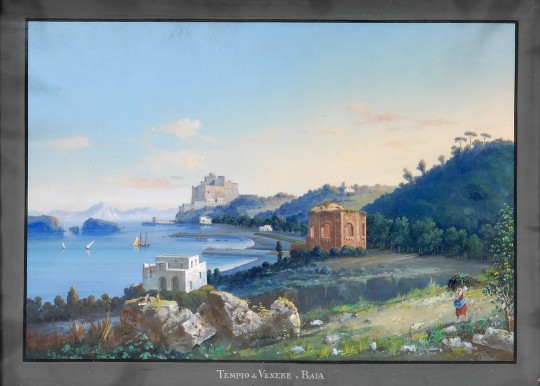
Tempio di Venere a Baia (19th century). Image source: WikimediaCommons.
During Roman times the upper classes had the extravagant habit of searching for elegant and expensive places outside the busy Roman capital, where they purchased fancy villas and luxurious mansions in which they spent their holidays and free time. They fancied spending some quality time far from Rome’s busy, noisy, and dusty metropolis, closer to the countryside in a place for relaxation and pleasure.
Wealthy Romans settled for Capri, Pompeii and Herculaneum. But there was one place that was far more exclusive and classy than the rest of the resorts, it was Baia or Baiae reckoned far superior and fashionable and the visitors that frequented the stylish and trendy thermal resort together with its residents in possession of lavish villas on its beaches and shores were of far higher status. It was the most privileged of the privileged of the Roman upper class, its “Elite”, and the affairs they were indulged in would prove to be far more illicit, shady and sinister than anywhere in the Roman Empire.
In Rome, nothing escaped the watchful eye of the powerful senate, which held an iron grip on Rome and its political leaders. But in Baiae, things were different, it was a place where everything was possible, here things happened through corruption, manipulation and bribes.
Baiae’s Potentials
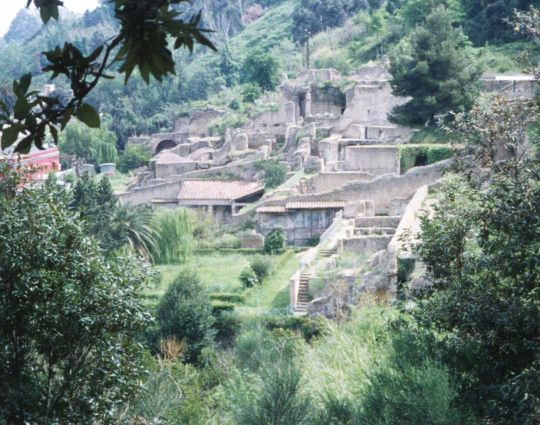
Roman ruins in Baiae, Italy. Image source: flickr.
From the beginning, Baiae wasn’t but an ancient, small, and insignificant Roman town on the northwest shore of the Gulf of Naples. But it was its temperate climate and famous mineral springs that first attracted the high Roman nobles to its shores.
With time it turned into a highly fashionable and popular holiday resort for the Roman Elite. Its caldera peppered coast and the proximity to Naples worked like an on Rome’s ultra-wealthy who took weekend trips here to party.
They were fascinated by Baiae’s thermal heated spas and mosaic-covered pools which created an amazing atmosphere where they could indulge their wildest desires. Here is where they came to carry out illicit affairs, more than 2000 years ago.
Baiae was located directly above a collection of natural volcanic vents which were famously acknowledged for their healing medicinal hot springs. The abundance of these hot springs soon created a grand collection of thermal baths as constructing these spas was easy thanks to the already existing natural springs. The public and private baths of Baiae were filled with naturally warm mineral water directed to the pools from the underground hot springs thanks to the Roman engineers who were able to construct a complex system of chambers that channelled underground heat into facilities that acted as saunas.
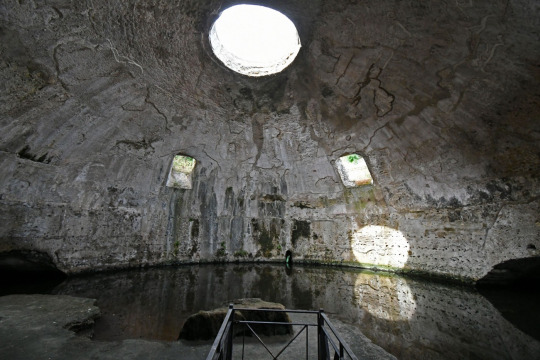
Temple of Mercury, Baiae. Image source: WikimediaCommons.
In addition to their recreational function, the baths were used in Roman medicine, to treat various illnesses, and physicians would attend to their patients at the springs. Baiae was supplied with fresh drinking water from a branch of the Aqua Augusta aqueduct; a cross-section of which can be seen nearby. The water was led via pipelines to an enormous cistern called “Piscina Mirabilis”, this gigantic freshwater cistern provided the whole city of ultra-rich upper-class citizens with fresh water.
Historical Figures in Baiae
There are many tales of intrigue surrounding Baiae, one resident is said to have constructed a Nymphaeum*, surrounded by marble statues and a private grotto dedicated exclusively to earthly pleasures. The guests would gather around the pools not only to bathe but also to have their dinner served as it came floating on enormous dishes down the water in the pools.
*The Nymphaeum served as a sanctuary, a recevoir and a chamber where weddings were held.
Sex scandals were everyday life, and old men came here to become young. Julius Caesar is said to have owned a magnificent mansion in the area, and after he was murdered, Cleopatra is said to have escaped in a boat from Baiae’s shores. Rulers such as Nero and Cicero had their pleasure palaces here and Haridian is said to have died on his property in this city in 138 AD.

The Hemicycle Nymphaeum Theatre, Archaeological park of Baiae. Image source: flickr.
Another dark story is the one when Julia Agrippina plotted her husband’s murder, so her son Nero could become Emperor, on these grounds. She poisoned Claudius with deadly mushrooms, but when he somehow survived the attempt Agrippina got her physician to administer a portion of poisonous wild gourd, which finally did the trick.
Baiae was known to be a prominent high-class resort for centuries, it catered the whims among the Roman Elite, it was, therefore, to expect its notorious reputation for its many hedonistic offerings together with widespread rumours of corruption and scandals. The reason the offerings were frequent was due to the fact that the city rested on natural springs, places that were prone to become offering sites in antiquity.
Baiae’s Connection to the Underworld
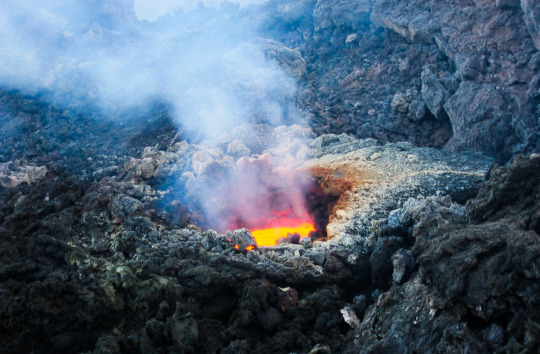
Sulphurous gas in a volcanic entrance to the underworld. Image source: Pxhere.
The calderas were revered by the Ancient Greeks and Romans as entrances to the underworld and thus had magical powers. But there is also a downside to this. Being close to the underworld means you are close to the gods, they will easily hear your prayers but somewhere on the “Phlegraean Fields” or flaming fields there was an opening guiding you to a long and complex underground tunnel network, it would lead you to the Great Antrum deep down in the ground. The Antrum was the portal to the cave leading to the underworld, through its opening flowed rivers of fire, the fabled rivers of Hades: The Styx and the Phlegethon “rivers of fire”, that boiled the souls of the departed.
Even among many mysteries of the ancient world, the great Antrum on the bay of Naples surely remains among the most intriguing. But the circumstances around the resort also encouraged technological advancements such as the local invention of waterproof cement. A cement that consisted of a mixture of volcanic rock and limestone, it prompted the construction of private fish ponds and lavish bathhouses. Most opulent villas had their own fish farm for their private consumption, but as the seawater in the pool quickly evaporated on hot days, it would become saltier and endanger the fish living in it.
The solution they came up with was to supply the ponds with fresh water, during hot summer days, to reduce the saltiness of the pond and prevent the fish from dying. Oysters were hung by the sea in nets, bound together by a rope, just as it is done today, which makes it easy to get to the oysters.
The area known to the Romans as “Phlegraean Fields” is the region containing the calderas and underground tunnel system that form part of a volcano, the twin of mount Vesuvius that destroyed Pompeii and Herculaneum. It once possessed a crater that measured 13 km (eight miles) across, but most of it is underwater now. The flaming fields contain a total of 24 volcanoes which together with the calderas defined the landscape, ironically it was a fitting name.
Baiae’s Downfall
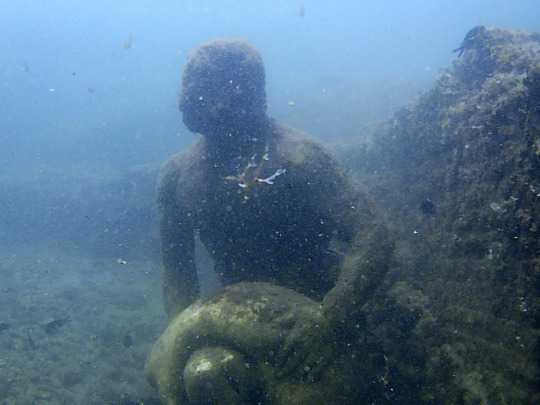
Remains of the Underwater Archaeological Park of Baiae. Image source: WikimediaCommons.
Given Baiae’s sinful reputation it was perhaps paradoxical that the abundant volcanic activity which was the reason for its rise also became its downfall. Over several centuries, bradyseism, the repeated and gradual fall and rise of the Earth’s surface, caused both by hydrothermal and seismic activity as a result much of the city sank into its watery grave, where it sits today. After having seen an aerial photo, taken in the 1940s, rumours started to spread about parts of a hillside with edifices, which had disappeared into the sea.
Twenty years later submarines scanning the area found the lost city, lost since Roman times. Underground pressure had caused the land surrounding Baiae to continuously rise and fall pushing the ancient city’s ruins upwards to the surface only to once again swallow them back into the sea, exactly like a kind of geological purgatory!
It was because of the undulation of the earth, the ruins still lie in relatively shallow waters. But not everything was swallowed by the sea, parts of the city partly escaped the punishment, and a portion of the old resort is still accessible on land; it consists of a barren rubble-strewn plateau. As a consolation, many of the sunken sculptures were actually replicas of the originals that can still be found up on the hill by Baiae Castle.
Fire burst from the rocks in places and clouds of sulphurous gas snakes out of vents leading up from the deep underground. However, the modern Baiae is but a shadow of what it once was, the part remaining on land is surrounded by a hot, smelly sulphurous gas and the part swallowed by the sea is perpetually punished in purgatory. The same forces that once made Baiae so attractive in the first place were to become the ones that destroyed it.
#history#writers on tumblr#writblr#writers#original content#travel#italy#roman#ancient rome#nero#julius caesar#cicero#julia agrippina#baiae#ancient history#resort
6 notes
·
View notes
Photo

P.S. Krøyer - Anna Palm, 1884, oil on canvas Anna Sofia Palm de Rosa (1859 – 1924) was a prominent Swedish watercolour painter. She enjoyed painting steamers, sailing ships and views of Stockholm and the Bohuslän archipelago. Anna was educated privately by her father Gustaf Wilhelm Palm, a portrait and history painter and an art teacher. Many artist friends visited the family household including Nils Kreuger, Gustaf Cederström, Georg Pauli and Vicke Andrén. Despite her talent, Anna was not able to study at the Royal Academy because she was a woman. However, in 1880, she received lessons from the history painter Edvard Perséus and the landscape painter Per Daniel Holm. During the summer of 1885, Anna visited an artist colony in Skagen, a remote fishing town in the north of Denmark. In 1895, at the age of 36, Anna left Sweden to spend a year in Paris, before moving to southern Italy. There, she married an infantry soldier, Lieutenant Alfredo de Rosa. While her husband was serving in the First World War, Anna travelled to the ancient Roman town of Baiae, where she painted marine subjects.
#P.S. Krøyer#Peder Severin Krøyer#ps kroyer#anna palm#Anna Sofia Palm de Rosa#anna palm de rosa#portrait#norweigian artist#swedish artist#swedish painter#realism#skagen painters#oil painting#oil on canvas#Brøndum's Hotel#side profile
11 notes
·
View notes
Text

Baiae (ancient Roman town situated on the northwest shore of the Gulf of Naples) / 2020
8 notes
·
View notes
Photo

A 2,000 year old sunken Roman mosaic being inspected by a lone diver. Once part of the town of Baiae, much of the ancient settlement is now underwater in the Bay of Naples.
PHOTO CREDIT: u/lowchan_r
0 notes
Link
“Baiae was the resort of choice for the Roman super-rich and became notorious for its sprawling mansions.”
Continue
#roman empire#classics#roman history#ancient rome#italy#baiae#morals#history#classical archaeology#archaeology#images#tagamemnon
507 notes
·
View notes
Video
youtube
Underwater world: Divers flock to Italy for Roman history lesson by Al Jazeera English Italy's tourism industry is gradually reopening after a third wave of COVID-19. One ancient Roman town is attracting a lot of attention. But it is not the scenic view above water that is drawing some people. The sunken town of Baiae was a popular getaway for the Roman Empire's elite - who flocked to the famous bathhouses, built opulent villas and held extravagant celebrations. But over time, volcanic eruptions brought that to an end, and about a thousand years later, a major eruption left the region submerged. Al Jazeera’s Jillian Wolf reports. - Follow us on Twitter: https://twitter.com/AJEnglish/ - Find us on Facebook: https://ift.tt/3x1dRtT - Check our website: https://ift.tt/2lOp4tL #Italy #RomanHistory #Baiae
0 notes
Text
Incredible Photographs Reveal Sunken City That Was Once The Playground Of Ancient Rome’s Rich And Famous
The city of Baiae was once a buzzing hive of Roman high-culture, filled with decadence, wine, and luxury. Over 1,700 years later since it enjoyed its happiest days, the grand city has been lost to the forces of nature and now lies deep below the waves. However, it has still managed to retain its beauty.
These stunning photographs by Italian photographer Antonio Busiello provide a rare glimpse of the once prosperous city.
Towards the end of the Roman Republic and the rise of the Roman Empire, Baiae was a popular resort for the mega-rich, where emperors and elites came to lap up the Mediterranean sun and splash their wealth.
The beautiful town featured cobbled streets, mosaics, statues, spas, and even the luxurious villas of Julius Caesar and Emperor Nero. It was also home to numerous grand temples dedicated to Mercury, Venus, and Diana. After lying untouched for centuries, the ruins have since become a haven for marine life.
Divers explore a stunning mosaic perhaps once the floor to a grand villa. ©Antonio Busiello
As a testament to their wealth, scientists recently discovered that Baiae’s villas were constructed using the finest white marble shipped from quarries across Italy, Turkey, and Greece.
The sunken city lies deep within the Gulf of Naples, a beautiful 15-kilometer-wide (9.3-mile-wide) gulf off the south-western coast of Italy. The city became submerged in the bay following centuries of seismic activity and volcanic activity. After all, the town lay near to Mount Vesuvius, the infamous volcano that destroyed the towns of Pompeii and Herculaneum in 79 CE with one of the most catastrophic volcanic eruptions in European history. This volcanic activity, however, did provide the city with geothermal energy to heat its spa waters and baths.
In 2014, there was heavy flooding south of Naples, causing a series of landslides to expose portions of the old Roman walls of Baiae. However, on the whole, the city’s ruins remain elusive and mysterious.
Marine archeologists also recently discovered a long-lost Roman city in the waters of northeast Tunisia, a short hop across the Mediterranean sea. On their diving expeditions, the team came across numerous Roman monuments, the ruins of structures, and around 100 tanks of garum – a fermented fish sauce known as “Rome’s ketchup”. Much like Baiae, this town was also sacked by forces of nature and seismic activity.
Although now taken over by the sea, the beauty and grandiosity of the city remains. ©Antonio Busiello
More From this publisher : HERE ; This post was curated using : TrendingTraffic
=> *********************************************** Read Full Article Here: Incredible Photographs Reveal Sunken City That Was Once The Playground Of Ancient Rome’s Rich And Famous ************************************ =>
Incredible Photographs Reveal Sunken City That Was Once The Playground Of Ancient Rome’s Rich And Famous was originally posted by 24 LI Health and Beauty
0 notes
Text
Ancient city lost for centuries below sea found perfectly intact...
Ancient city lost for centuries below sea found perfectly intact…

Baiae was an ancient resort on the west coast of Italy that largely disappeared beneath the waves 1,700 years ago. The town in Naples was the resort of choice for the Roman super-rich and became notorious for its sprawling mansions. It was a place synonymous with luxury and wickedness, historians claim – a wine-soaked party town. But as the centuries passed, much of it was lost to the sea as…
View On WordPress
0 notes